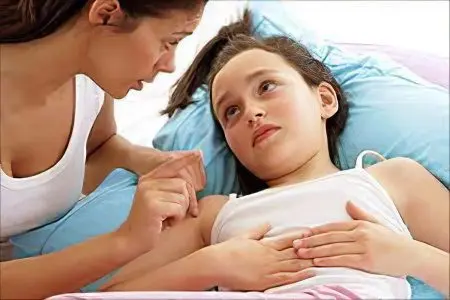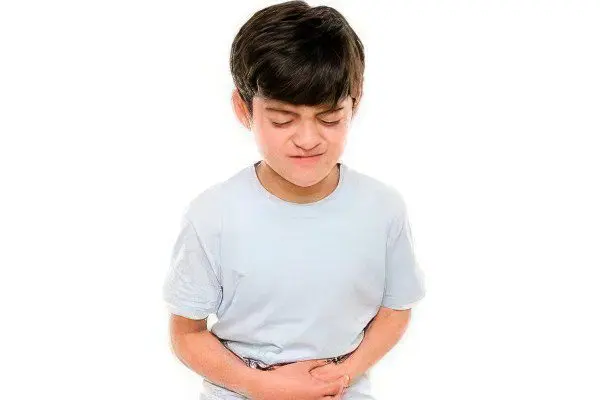Contents
When a child begins to hurt his stomach, do not write off the possibility of inflammation of the appendix. Try as soon as possible to get an appointment with your doctor so that he can examine and confirm or refute your fears. Acute appendicitis most often occurs in children.
Before doctors, the task of making a diagnosis for pain in the abdomen becomes more complicated at times if they have a small patient in front of them. A child often simply cannot tell in detail about the nature and focus of pain, everything hurts him and very much.
Inflammation of the appendix is most often observed in children aged 9-13 years – 13-20%. Less common in preschoolers, only 10-12% of cases. Most often, 70-75% is adolescence 14-19 years. In infants, inflammation of the appendix is extremely rare. The reason for this is the immaturity of their digestive system.
Features of the course of appendicitis in children

After the child is 7 years old, the first signs of appendicitis will be the same as in most adults. Despite this similarity, making a correct diagnosis can be complicated by the fact that the child is frightened, may act up and cry. A lot of children are simply afraid of the operation, which is why they can say that their stomach has stopped hurting and everything is fine, anything, just to stay at home.
Usually inflammation of the appendix occurs unpredictably. This can happen both on weekends at home, and in kindergarten, and on a walk, and even at a party. In children under 3 years of age, from the very beginning of the disease, deviations in behavior can be noticed: they refuse to eat, act up, sleep poorly and become noticeably less active. Babies won’t be able to tell you exactly where it hurts. They will point to the whole stomach, claiming that it hurts everywhere. The strongest reaction of the baby can be observed on the first night after the onset of the inflammatory process, his sleep will be very restless, with periodic waking up and screaming. And also with accidental touching of the tummy in the navel. The pain may increase when dressing or bending to the right, lying on the right side.
Please note that with inflammation of the appendix, the baby may feel sick and vomit, diarrhea may also be present, while some mucus is often present in the feces. Less common is just a delay in stool. Severe pain in the abdomen will also be accompanied by pain when urinating. A high temperature will also speak about the inflammatory process, which can rise up to 40 °. Although in children who are breastfed, the temperature often does not rise above 37,5 ° for quite a long time.
During the game, the child may cry very much when squatting, pulling his right leg towards him, in an attempt to reduce pain or take the most comfortable position.
In view of the peculiarities of the structure of the intestine, appendicitis very rarely occurs in children under 2 years of age.
If the child is older, then he is already more or less clearly and clearly able to tell his mother when his stomach began to hurt. At the same time, it will not be possible to notice any changes in his usual behavior. Children over 3 years old can tolerate mild pain without telling their parents about it, in the hope that he just ate something wrong and after a while everything will go away on its own. They are already at a more conscious age, so they can indicate exactly where the pain was localized. If the painful area is near the navel, slightly above it, this is only the beginning of inflammation of the appendix. Everything is much more serious if the lower abdomen hurts, closer to the right side. When moving, the pain can become much stronger, and also if you lie on your right side. The child can tell what kind of pain he is experiencing: severe sharp or aching dull.
The very first signs of appendicitis in this case will be lethargy, vomiting and nausea. In children older than 3 years, diarrhea is unlikely, more likely just stool retention, but not constipation. An increase in body temperature within 38-39 ° is also an indicator of the inflammatory process in the child’s body. When you change the position of the body, the nature and strength of the pain may change. For example, if the child is placed on the left side, this will significantly reduce pain.
The first signs of appendicitis in children

Appendicitis occurs when an appendix of the caecum, the appendix, becomes inflamed and is about 6 cm long. The signs and symptoms of this disease in children can also be similar to many other diseases.
The first signs of an inflammatory process will always be pain in the abdomen. Most often, the initial localization of pain is the navel area, a couple of fingers above it and not very painful, slightly perceptible. Over time, the pain is able to move closer to the lower abdomen and right side, while it becomes much stronger.
The condition of the child with inflammation of the appendix will noticeably worsen: in addition to lethargy, weakness and high fever, nausea or vomiting may begin. And this happens repeatedly. Children begin to hysteria and act up, refuse their favorite food.
When touched on the stomach, babies may scream out sharply, start crying and try to wriggle out so that you leave them alone and do not touch them again.
An increase in temperature in children does not always occur, so this is not the main sign of appendicitis.
If you notice this behavior in your child, be sure to try to palpate his stomach to find out the location of the pain. Try to do this very carefully so as not to harm the baby. If it hurts more on the right side, you should lightly press on the stomach in that area with a few fingers, maybe that’s where you will feel a slight seal. With inflammation of the appendix, the pain will intensify if you sharply remove your fingers from the place of pressure. You can also ask the child to cough or laugh if the pain intensifies with such actions – this indicates the presence of acute appendicitis. Call an ambulance immediately so that the doctors can make the correct diagnosis in time and provide the child with the necessary assistance.
In no case do not hesitate to seek medical help. Delay can contribute to the fact that appendicitis will turn into peritonitis, which is a complication of the disease. An inflamed appendix can burst at any time, while all its contents, including pus, will end up in the child’s abdominal cavity. At what point in time this can happen, even the most experienced physicians cannot predict. It is better to call the doctor once again and make sure that these are just intestinal colic. In any case, you just take a blood and urine test of the child, they will show the big picture. According to their results, you can immediately judge whether your excitement is justified or not.
Almost always, appendicitis is treated only surgically, by removing the process of the caecum from the abdominal cavity. It takes a little less than a week to recover after a 20-minute operation so that the child can return to his usual way of life again. This is provided that after the operation there will be no complications.
Causes of appendicitis in children

Despite how advanced medicine is now, no one can still say with 100% certainty for what reason appendicitis occurred in a particular child. Doctors are sure of one thing for sure: for inflammation of the appendix to occur in the intestine, bacteria must be present, and the lumen of the process of the caecum must be clogged. Only with the simultaneous presence of these two conditions does appendicitis occur.
A blockage of the appendix occurs due to excessive eating of seeds, seeds, or stool that enters the lumen.
Doctors also identify several reasons why inflammation of the appendix can also occur:
low immunity. The child’s body can not cope with the attack of viruses, the infection penetrates into the abdominal cavity, and then into the vermiform appendix of the caecum, the inflammatory process begins;
frequent colds, tonsillitis, acute respiratory viral infections, otitis media, laryngitis, sinusitis and other diseases can provoke a decrease in immunity. As a result, the body is weakened, can not cope with the bacteria that penetrate it, therefore, appendicitis occurs and sometimes a severe course of this disease, with various possible complications;
foreign objects or helminths (worms) that have entered the intestines. Often, children swallow unpeeled seeds, unnoticed fish bones or bones along with berries, resulting in a blockage of the lumen of the appendix (inflammation of the appendix).
Complications of appendicitis in children
Acute appendicitis is a very specific disease that most often occurs in adolescents and children over 3 years of age. In adults, it also occurs, but at times less. Nevertheless, in all cases of occurrence, inflammation of the appendix is treated surgically, by removing the process of the caecum during laparoscopy. During this operation, small incisions are made on the abdomen, through which the clogged organ is removed.
Many patients seek qualified medical care almost at the last moment. Such a negligent attitude to one’s health is a common cause of various complications after surgery, sometimes during it.
Any complications associated with the postoperative period are divided into the following five categories:

poorly healing postoperative wound;
suppuration of the seams;
the formation of hematomas and swelling in the suture area;
various complications from the abdominal cavity;
subphrenic abscesses.
Swelling and hematomas in the area of the wound and sutures are formed quite often in the first few days after surgery. They gradually resolve on their own and do not require any additional treatment.
The most common complication is wound suppuration. This form occurs mainly due to the fact that not all the pus was sufficiently well removed from the abdominal cavity after the rupture of the appendix. As a result, microbes remain in the body, causing a similar complication. To treat this problem, patients are given broad-spectrum antibiotics, the stitches are removed, and the wound is washed. Special bandages impregnated with antibacterial solutions and drugs are placed on its edges. The duration of such manipulations and the elimination of complications directly depends on the stage of suppuration and its form.
In children, more often than in adults, the most dangerous complication occurs – from the abdominal cavity. Sometimes, due to untimely actions of the attending physician, such a complication can cause the death of a child.
This complication includes peritonitis, various abscesses, internal bleeding arising from damaged vessels and tissues. Damage is caused by the contents of a ruptured appendix. Such complications appear only on the 6-9th postoperative day. The first reasons will be a sharp unreasonable increase in temperature, a sharp pain in the right side, very similar to the one that the patient experienced before the operation.
The rarest complication in children after surgery is subdiaphragmatic abscesses. Most often, the symptoms of complications are pronounced and noticeable immediately: fever, intoxication, severe shortness of breath, severe chest pain when inhaling.
The most difficult thing in this case is to correctly determine the location of the resulting abscess. This complication is very difficult to diagnose. When such a diagnosis is made, treatment is carried out, only surgically. Since the abscess must be opened and all accumulated pus removed by inserting a catheter to drain it.
Author of the article: Sokolova Praskovya Fedorovna, pediatrician









